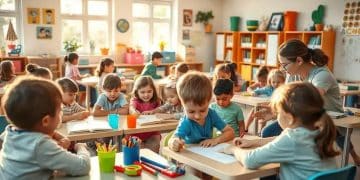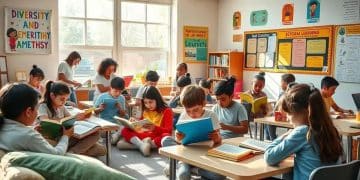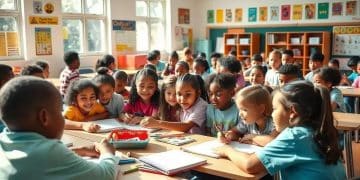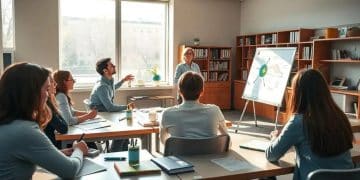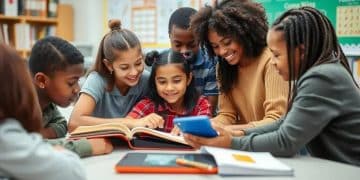Positive early childhood learning: unlocking potential
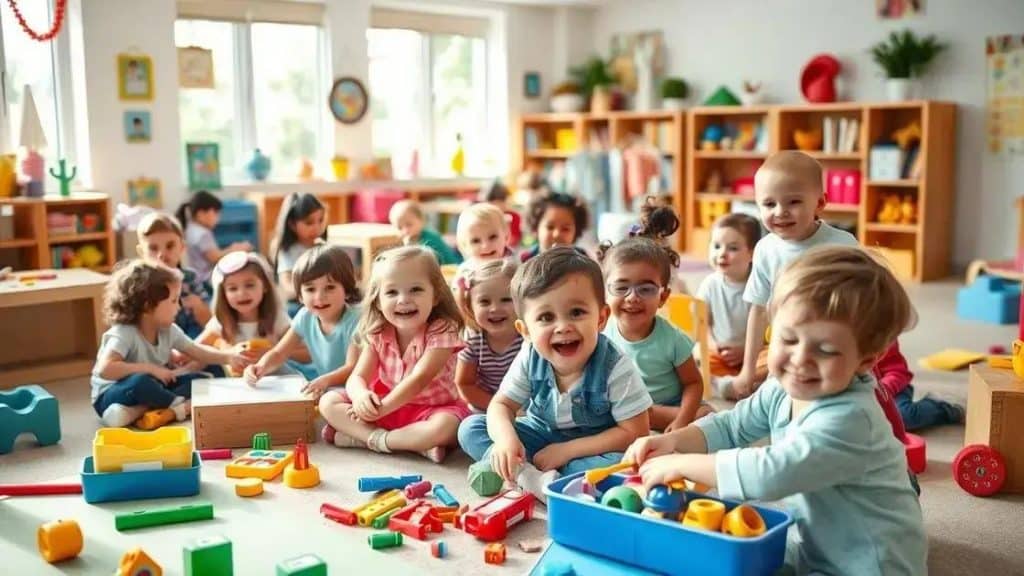
Measuring success in early childhood education involves using diverse assessment methods, setting clear goals, and fostering collaboration between educators and parents to enhance children’s development and learning outcomes.
Positive early childhood learning plays a vital role in shaping children’s future. Have you ever considered how the early experiences of a child can influence their entire life? Let’s dive into the elements that create a nurturing educational foundation.
Understanding the importance of early childhood learning
Understanding the importance of early childhood learning is essential for fostering a supportive environment for children. Early experiences shape cognitive development and emotional well-being, setting the stage for lifelong learning.
Key Factors in Early Childhood Learning
Several factors contribute to the effectiveness of early childhood education. Creating a safe and stimulating environment allows children to explore and engage.
- Play-based learning: Engaging children through play fosters creativity and problem-solving skills.
- Social interaction: Interacting with peers helps develop communication and collaboration skills.
- Routine and structure: Consistent routines provide a sense of security and help children understand expectations.
As kids engage in different activities, they learn not just academically, but also socially and emotionally. This holistic development is crucial during their formative years. Teachers play an integral role in facilitating this process, guiding children through diverse learning opportunities.
Long-term Benefits of Early Learning
The benefits of positive early childhood learning extend far beyond preschool. Research shows that children who receive quality early education are more likely to succeed in school and life.
Investing in early learning programs can lead to better outcomes in various areas, including:
- Improved academic performance in later years
- Increased graduation rates
- Enhanced social skills and emotional resilience
These advantages highlight the impact that a solid early education can have on a child’s future. Parents, educators, and communities must work together to prioritize and support early childhood learning initiatives. By doing so, we can ensure that every child has the opportunity to thrive.
Key approaches to foster positive learning environments
Key approaches to foster positive learning environments are vital in ensuring that children thrive in their educational journeys. A supportive setting enhances children’s ability to learn and develop essential skills.
Creating an Engaging Atmosphere
One way to promote a positive learning environment is to create an engaging atmosphere. This can involve colorful decorations, interactive displays, and comfortable seating. When children find their surroundings inviting, they are more likely to participate actively.
- Use of visuals: Incorporating colorful posters and educational materials can spark curiosity.
- Flexible seating arrangements: Offering different seating options can accommodate various learning styles.
- Inclusive decorations: Featuring materials that reflect diverse backgrounds enhances connection.
In addition, establishing clear routines helps children understand what is expected of them. When your class has consistent schedules, students feel secure and more willing to engage with the material.
Encouraging Positive Interactions
Encouraging positive interactions is another crucial aspect. When children feel safe to express themselves, they learn better and build stronger relationships with peers. Teachers can model respectful communication, showing students how to listen and respond constructively.
Building a community spirit involves:
- Group activities: Foster teamwork and collaboration among students.
- Peer mentoring: Pairing older and younger students encourages support and guidance.
- Celebrating achievements: Recognizing individual and group successes boosts morale.
Furthermore, involving parents and caregivers in the learning process promotes a supportive network. Workshops and open communication foster collaboration between home and school, reinforcing the importance of positive learning experiences for every child.
Overall, by focusing on these key approaches, educators can create enriching environments where children feel valued, secure, and eager to learn.
Strategies for parents to support their children

Strategies for parents to support their children in their learning journey are essential for fostering both academic success and emotional well-being. Engaging with children actively can make a significant difference in their development.
Creating a Supportive Home Environment
One effective strategy is to create a supportive home environment. Parents can establish a routine that includes designated study times, which helps children understand the importance of education.
- Designate a study space: Ensure children have a quiet, organized area for homework.
- Limit distractions: Reduce noise and interruptions during study time to maintain focus.
- Encourage reading: Invest in books and reading materials that cater to their interests.
This not only enhances their learning but also fosters good study habits. Additionally, showing enthusiasm for learning can motivate children to engage more fully in their education.
Active Participation in Education
Parents should also aim to be actively involved in their children’s education. This can include attending school events and engaging with teachers to stay informed about their child’s progress.
Another vital aspect is to:
- Ask about their day: Open conversations about school can encourage children to share their experiences.
- Practice skills together: Join them in activities like reading or math games to make learning fun.
- Be their advocate: Support your child in overcoming challenges at school by communicating with teachers when needed.
Moreover, parents should encourage the development of problem-solving and critical thinking skills by allowing children to face challenges independently while providing guidance when necessary. This balance helps children build confidence in their abilities.
Ultimately, implementing these strategies can create a nurturing environment that empowers children, allowing them to thrive academically and socially.
Role of educators in promoting effective learning
The role of educators in promoting effective learning is crucial in shaping a child’s educational experience. Teachers not only impart knowledge but also create an environment that encourages curiosity and engagement.
Creating a Positive and Inclusive Environment
One significant way educators promote effective learning is by creating a positive and inclusive classroom atmosphere. This environment allows all students to feel valued and respected, which is essential for their learning progress.
- Encouraging participation: Teachers can use various strategies to ensure that every student has a chance to contribute, such as group discussions and interactive activities.
- Differentiated instruction: Adapting lessons to meet the diverse needs of students helps everyone learn at their own pace.
- Cultivating relationships: Building trust and rapport with students encourages them to express themselves freely.
When students feel secure and included, they are more likely to engage deeply with the material and take risks in their learning.
Utilizing Engaging Teaching Methods
Another important aspect of an educator’s role is utilizing engaging teaching methods. Incorporating a variety of instructional strategies can cater to different learning styles, making lessons more effective.
Innovative approaches can include:
- Hands-on activities: Activities such as experiments and projects help students connect theoretical concepts to real-life applications.
- Technology integration: Utilizing educational technology can enhance learning experiences and keep students interested.
- Collaborative learning: Group work fosters teamwork and social skills while enabling students to learn from one another.
By implementing these methods, educators help students develop critical thinking skills and a love for learning. The goal is not just to teach content but to inspire children to become lifelong learners.
Overall, teachers play a vital role in shaping learners by creating supportive environments and employing effective instructional strategies that resonate with their students.
Measuring success in early childhood education
Measuring success in early childhood education is critical to understanding how well programs serve children and families. Effective assessment methods help identify areas of strength and areas that need improvement.
Assessment Methods
There are various ways to measure success in early childhood education. These methods can include observations, standardized assessments, and portfolios.
- Observational assessments: Educators watch children engage in activities to see how they interact with peers and handle challenges.
- Standardized tests: These tools provide benchmarks for evaluating children’s skills in areas like literacy and math.
- Portfolios: Collecting samples of children’s work over time helps showcase their progress and development.
By using a mix of these methods, educators can gain a comprehensive understanding of each child’s learning journey.
Setting Goals for Improvement
Another important aspect of measuring success is setting clear goals for children’s development. Having specific learning objectives can guide educators in planning lessons that meet individual needs.
Goals should be:
- Developmentally appropriate: Ensure targets are realistic based on children’s ages and capabilities.
- Aligned with standards: Follow educational standards to make sure teaching practices are effective.
- Measurable: Use criteria that allow for tracking progress over time.
Regularly reviewing these goals helps educators adapt their teaching methods to better support each child, encouraging growth in all areas.
Ultimately, measuring success in early childhood education is an ongoing process that requires collaboration among teachers, parents, and other professionals. By continuously evaluating and adjusting their approaches, they can create a supportive environment that nurtures each child’s potential.
FAQ – Frequently Asked Questions about Measuring Success in Early Childhood Education
Why is it important to measure success in early childhood education?
Measuring success helps identify children’s strengths and areas for improvement, ensuring effective support for their development.
What are some common assessment methods in early childhood education?
Common assessment methods include observational assessments, standardized tests, and collecting student portfolios.
How can educators set effective goals for children?
Goals should be developmentally appropriate, aligned with educational standards, and measurable to track progress.
How does collaboration with parents benefit early childhood education?
Engaging parents in the educational process fosters a supportive environment and enhances children’s learning experiences.

